![]()
![]()
![]()
Use LEFT and RIGHT arrow keys to navigate between flashcards;
Use UP and DOWN arrow keys to flip the card;
H to show hint;
A reads text to speech;
37 Cards in this Set
- Front
- Back
|
Outer-most layer of the blood vessels is the....
|
tunica externa (EX = outside)
|
|
|
Inner-most layer of the blood vessels is the....
|
tunica intima (IN = inside)
|
|
|
Middle layer of the blood vessels is the....
|
tunica media (MED = middle)
|
|
|
The blood vessel that can have valves to prevent back flow of blood is the...
|
vein
|
|
|
The thickest-wall blood vessel is ....
|
an artery
|
|
|
The blood vessel that has only the tunica intima is...
|
capillary
|
|
|
The inside of the tunica intima is ____ to let blood flow smoothly, even in very narrow passages.
|
very slick
|
|
|
The open part of a blood vessel is called the....
|
lumen
|
|
|
A capillary a single layer of ...
|
endothelium
|
|
|
The tunica externa is also called....
|
adventitia
|
|
|
The layer that can contain smooth muscle and elastin is the....
|
tunica media
|
|
|
A recording of the electrical activity of the heart is an...
|
electrocardiogram (ECG or EKG)
|
|
|
An abnormally slow heartbeat, less than 60 beats per minute, is called....
|
bradycardia
|
|
|
An abnormally fast heartbeat, greater then 100 beats per minute, is called....
|
tachycardia
|
|
|
Check pain is also called...
|
angina pectoris
|
|
|
The part of an ECG that shows when the atria are depolarizing is the ____ wave.
|
P
|
|
|
The part of an ECG that shows when the ventricles are repolarizing is the ___ wave.
|
T
|
|
|
The part of an ECG where the ventricles are depolarizing, which precedes their contraction is the....
|
QRS waves
|
|
|
A condition in which the heart is firing in a random, uncoordinated fashion, making it useless form pumping blood is called.....
|
fibrillation
|
|
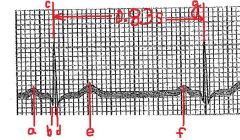
Repolarization of the ventricles is occurring at letter....
|
E
|
|
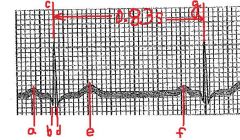
The time from A to F or from C to G is consider to be....
|
one heart beat cycle
|
|
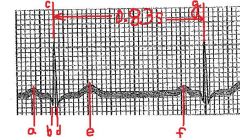
The depolarization (firing) of the atria is occurring at letter ____, also known as the ____ wave.
|
A
P |
|
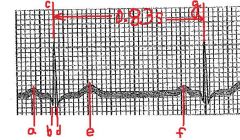
Depolarization & subsequent firing of the ventricles is represented by __,___,___, also known as the _____ complex.
|
BCD
QRS |
|
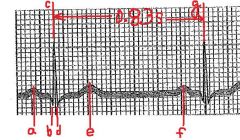
Use a calculator for this one. It takes 0.83 seconds to get from Peak C to Peak G. How many beats per second is this heart and also, how many beats per minute is it?
|
1.2 beats per second [1 beat / 0.83 seconds = 1.2 bps]
72 beats per minute [1 bps x 60 sec/min = 72 bpm] |
|
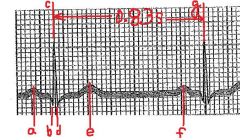
The peaks at C & G are typically called ___ waves.
|
R
|
|
|
The period when the ventricles are resting and filling with blood is known as...
|
diastole
|
|
|
The period when the ventricles are contracting while the atria are filling/resting is known as...
|
systole
|
|
|
The movement of blood to and from the heart muscle, providing it's nourishment is called ___ circulation.
|
coronary
|
|
|
The movement of blood to the body is called ____ circulation.
|
systemic
|
|
|
During _____ the ventricles are filling with blood.
|
diastole
|
|
|
In blood pressure lingo, the systole number is where and diastole number is where?
|
systole over diastole.
[Think of di- as de-nominator.] |
|
|
Normal BP is about ___ over ____.
|
120/80
|
|
|
Which number is "systole" for the atria?
|
diastolic
|
|
|
Increased pressure in the arteries is referred to as...
|
high blood pressure
|
|
|
Blockage to the coronary artery, which nourishes the heart, is called....
|
coronary thrombus
|
|
|
An inadequate supply of oxygen to the heart because of narrowing of the coronary arter (ischemia), and is painful, is called...
|
angina pectoris
|
|
|
AV node damage, resulting in a loss of control of the ventricles is called a...
|
heart block
|

